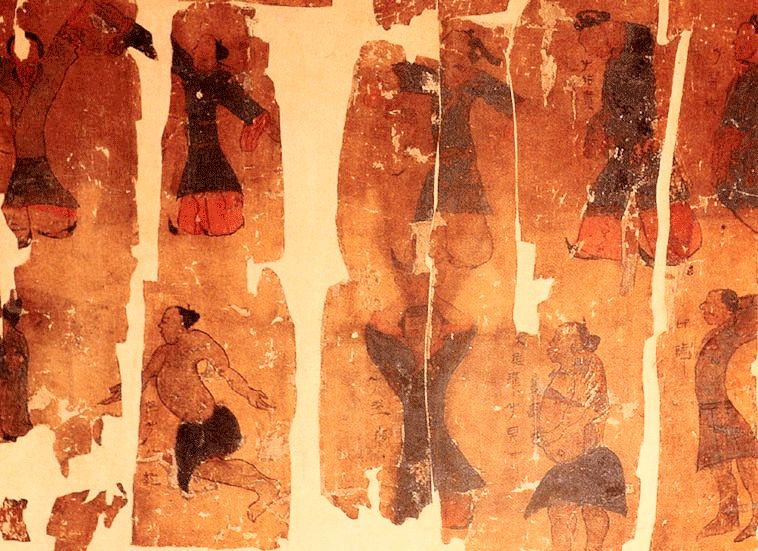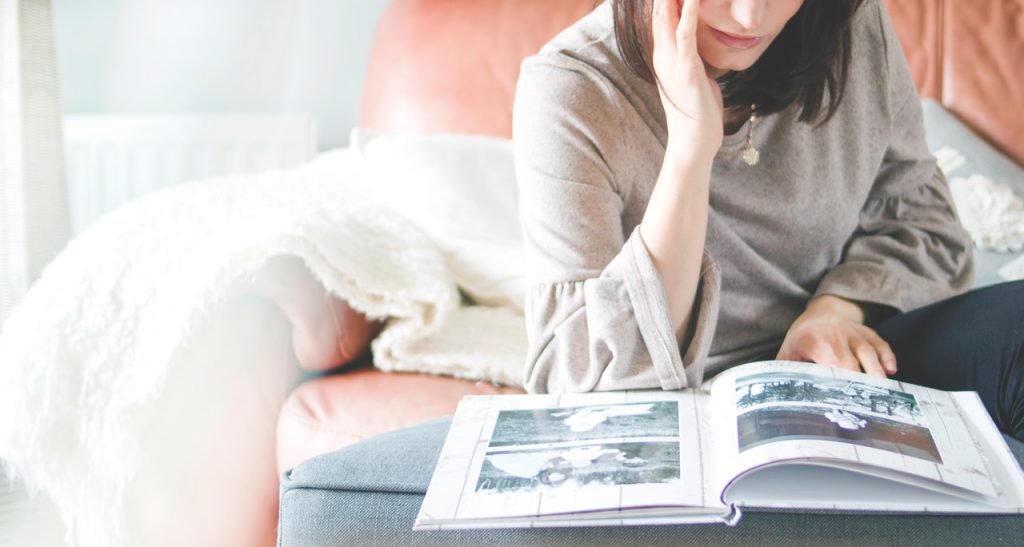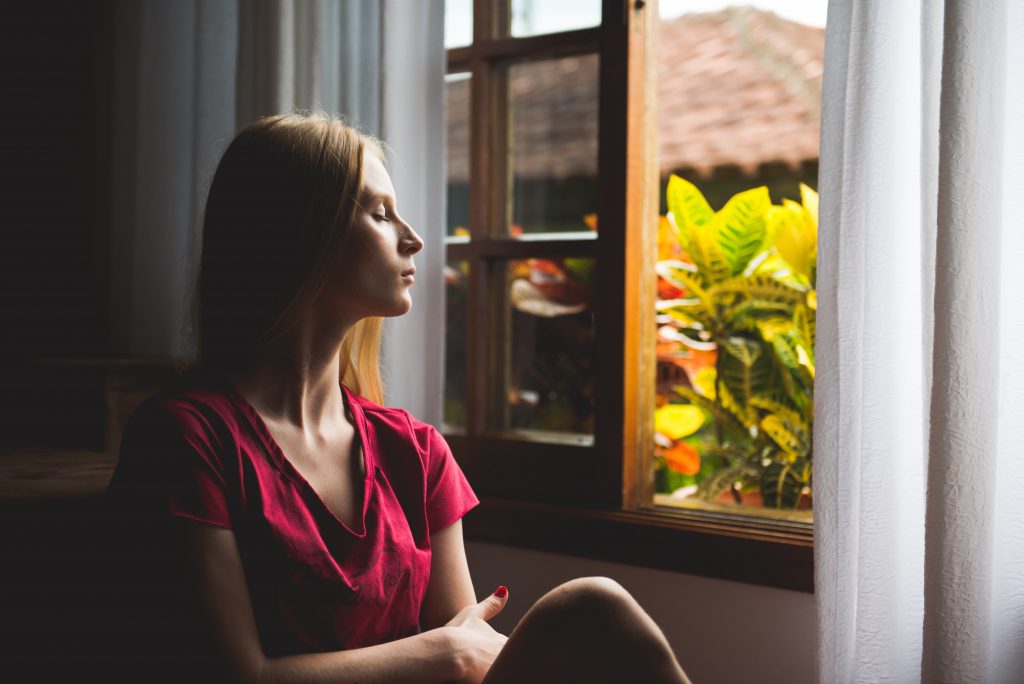Meditation is a fascinating part of humanity’s history. It has evolved into a mosaic of disciplines, across numerous cultures and civilizations over thousands of years. That makes it challenging to narrow down a definition but at its core; meditation involves using a specific method allowing a person to focus their mind on a thought, activity or object to achieve mental clarity and calmness.
This very generalized definition creates many misconceptions around what meditation is and how to use meditation for anxiety. Although much of its history is tied to spirituality, today meditation is used by medical and mental health professionals as part of a holistic treatment for mental health.

Deceptions of Chinese Breathing exercises found in a burial site from 200 AD.
Benefits of Meditation for Anxiety
Even though meditation has been practiced for generations around the world, it’s only in the last few decades the scientific community has begun to seriously study the impact of meditation on the human body and brain. Although there is still much we don’t know, the consensus among researchers is that meditation offers many benefits for people looking to curb their anxiety and stress.
Helps With Focus
Generally, most meditation techniques work on improving our attention spans. But research has shown that it can help train our minds from wandering and better yet, the effects of this training can last for years.
Helps us Manage Stress Over the Long Term
Breathing is connected to how our body processes many emotions, especially the ones linked to our “fight or flight” responses. When our stress levels spike due to a real or perceived threat, adrenaline races through our body. Our heart rate speeds up, blood pressure rises and our breathing rate doubles to nearly twenty breaths per minute.
Studies have now shown that specific breathing techniques can calm our emotions and body during periods of high stress. Since breathing is a cornerstone of meditation, it makes sense that meditation is a powerful method for dealing with anxiety.
It Increases Our Empathy
The exact reasoning is still unclear but researchers suspect that the inherent introspective and positive nature of meditation helps people evaluate their place in the world. There is also evidence that meditation activates the parts of our brain responsible for kindness and love.
Has a Positive Impact on Your Body
We are not talking about changing the physical makeup of your body; the impact comes in the form of preventive maintenance. High blood pressure, tension, chest pains, insomnia and indigestion; these ailments are often a byproduct of high stress and anxiety, which takes a physical and mental toll on the body. Breathing and meditation can help people control and manage their stress levels, which in turn reduces the harm done to your body and mind.

There is also research meditation can improve long-term memory
A Beginners Guide to Meditation for Anxiety
Just like other forms of exercise or discipline, meditation takes practice and patience. Your “meditation muscles” will take time to build their strength and stamina. Sometimes this can make the thought of meditation intimidating for people. If that is the case for you, you may want to try these simple breathing exercises for anxiety. These exercises are often an excellent place to start for beginners. Once you have mastered those techniques, the next step to a more mindful existence is meditation.
Set a Goal
Before you get into a meditative mindset, it will make a dramatic difference to ask yourself this question, “What do I want to achieve?”. Using meditation for anxiety can be just one goal. Maybe you want to settle your mind, possibly boost your creative output or discover new ways to connect with your body. There is no “wrong” reason to bring meditation into your life. If you are new to the world of meditation and aren’t sure what you want to focus on, keep things simple. You can simply use meditation to give your brain and body a rest.
Sounds of Silence
During your first few rounds of meditation, it’s best to practice in an area that is free of distraction. Although it isn’t necessary, a quiet environment helps you focus during the beginning of your meditation journey. This means no TV or music but also noises from the outside world, seeping in through an open window, can be disruptive. Once you can exercise more control over your mindfulness, noise tends to be a minor distraction. In the meantime, try to keep the sounds to a minimum. And a pro tip: try to keep your meditative space dark or dim.
Clothes Make the Meditation
You may think your designer jeans are suited for any occasion. However, for meditation, they likely won’t fit the bill. Yoga attire, your favorite pajamas or any unrestrictive and comfortable clothes are best for staying focused and relaxed.
Get Comfy & Cozy
This is an absolute must. Having a relaxed body is the key to having a relaxed mind. With meditation, we often envision people sitting on the ground or a cushion with their legs crossed. This works well for veterans but can often feel unnatural when starting out. First-timers typically find sitting in a chair with good posture to be the most natural approach. You simply need to find the position which works for you. The goal is to put your body at ease.

Even your favorite spot in the house will be great
Getting Started
Now that you are in a comfortable position, it’s time for the last few steps before you begin meditating. You can keep your eyes open or closed but you may find keeping them shut is easier. And don’t worry about your hands, they don’t need to be in any specific position. Simply do what feels natural. And a pro-tip: set an alarm for say five or ten minutes. This helps you stay focused without worrying about time passing.
Types of Meditation for Anxiety
Measured Breathing
This is one of the easiest ways into the world of meditation. It combines simple breathing techniques with basic counting to help you maintain focus. Measured breathing sometimes used as an umbrella term for various types of counting meditations. We covered one, Box Breathing, in our list of the best breathing exercises for anxiety. Another popular one is the 4-7-8 breathing technique, promoted by Dr. Andrew Weil:
- Once you get comfortable and are prepared to start meditating, place the tip of your tongue against the top of your mouth and behind your front teeth.
- First, empty your lungs of air and then breathe in quietly through your nose and count to four.
- Hold this breath in your body and count to seven.
- Finally, exhale through your mouth, while making a “whoosh” sound and count for eight seconds.
- Repeat this process three more times, for a total of four.
If you find this technique tricky, try counting with each exhale. Start at one and then with the next exhale count “two” and so on. Do this until you reach the number ten. Once you hit ten, start counting backward. It’s okay if your mind drifts and you lose your place, simply start over again. This exercise is a great way to build up mental power and discipline.
Humming Breath
This technique is similar to mindfulness meditation and is often associated with a type of yoga. You will start off in the same manner as other meditations. The key difference here, is that you will hum while breathing. After you inhale, begin to hum softly and lightly, while focusing on the humming. Try to make the sound and sensations of the humming the only thing in your thoughts.
Take note of the sensation of the humming flowing through your head, chest, legs and other parts of your body. You can repeat the hum eight to ten times (during each breath) or set an alarm to go off after a certain period of time.
Feel free to change up the volume, the tone or the pitch of the hum. Once you have finished the humming breath exercise, focus on the silence and how your body feels since you began. You will likely notice a sense of stillness that has eradicated any stress or anxiety.

With practice, you will be able to meditate anywhere if needed
Alternate Nostril Breathing
Again, start by going through the regular pre-meditation routine we outlined in the beginner’s guide. Now follow these steps:
- Close your right nostril with fingers from your right hand (usually the pointer and middle finger).
- Inhale slowly through your left nostril and then close this same nostril with your left land.
- Hold the breath for a pause.
- Now open up your right-side nostril and slowly let the air out through your nose.
- Hold for a pause.
- Now inhale slowly through the right nostril, while keeping the left one closed.
- Hold the breath for a pause.
- Open up the left-side nostril and expel the air.
Repeat this whole process for about five to ten times on each side. Alternate nasal breathing will benefit you in a few ways. Slowing down while extending the process of inhaling and exhaling, will trigger the mind to slow down. This will in turn help focus your thoughts and quiet stressful emotions. Additionally, breathing through your left nostril directs oxygen into the right hemisphere of your brain, which turns on the parasympathetic nervous system. This also will increase feelings of relaxation.
Visualization Meditation
Research has shown that a positive outlook keeps you healthier physically and mentally. For decades athletes, performers and entrepreneurs have tapped into the power of visualization to help achieve their goals. But it can also be used to manage stress and anxiety. It primarily comes down to controlling the thoughts which are in your mind.
Visual meditation is often seen as a more advanced technique. Try no to let that discourage you; as with any new method, practice makes all the difference. The goal of this technique is to imagine being transported to a specific place. A unique but comfortable space within your mind’s eye. This can be a place you are familiar with or one you have seen before in pictures. Here is how to approach it:
- Sit somewhere quiet and peaceful
- Take five deep breaths
- Begin to slowly visualize a space or setting which calms you – for example, sitting on a mountainside over a lake.
- (Keeping with our example) Start imagining the larger view first, such as the expansive treescape surrounding you.
- Slowly zoom into the setting, noticing all the more intimate details: birds singing in a quiet, steady rhythm or the sound of the wind moving through the leaves.
- Now take notice of your body reacting to this environment: the air tickling the air of your skin or how the sun warms your body.
- Finally, cast out any negative thoughts which have clogged up your mind
- Watch these negative thoughts disappear into the ethers
With enough practice, using visual meditation for anxiety can help lower stress levels, blood pressure, even chest pains and headaches.

The commute home is a great opportunity to practice
Mindfulness Meditation
The word “Mindfulness” is now commonly used in society but the habit of being “Mindful” is rooted in spiritual practices (like Buddhism) which have been practiced for millennia. Today universities, private businesses and even the military practice or offer some form of mindfulness program. One of the core elements is mindfulness meditation, which has been shown to reduce stress, anxiety and help people think more clearly.
Similar to visual meditation, it takes some practice to get the hang of it. Let’s go through the steps. Like the other meditation techniques we discussed, start by finding a comfortable and quiet place:
- Set a timer for ten or twenty minutes.
- Breath in through your nose and exhale out your mouth.
- Take notice of the breath as it passes above your lip and below your nose.
- Notice how the air enters and leaves your body; how your belly or chest rises and falls.
- You may also focus on the differences between each individual breath – like trying to see the uniqueness of a snowflake
- Now observe your thoughts as they come and go. Take note of the emotions with each one.
- Don’t fight or dwell on these thoughts. Acknowledge them and watch them pass through your mind, like you are having an “out of body” experience.
- Try to stay in the present and not drift to the past or future.
- If you lose focus or become entranced in thought; go back to focusing on your breathing.
- When the timer goes off, take a few minutes to become more alert and connected to the environment.
This technique takes time to master so please don’t feel discouraged if you struggle at the start. We are positive that with some practice, this method is one of the best meditations for anxiety.
Just Getting Started Using Meditation for Anxiety is Key
People often find getting started with meditation a daunting task. The hundreds, if not thousands of options available out there can be overwhelming. That’s why we created the Mindbliss app. It has been specially designed to help guide and accelerate your evolution in mindfulness. It runs on an intelligent algorithm dedicated to curating the ultimate meditation experiences to fit your needs.

